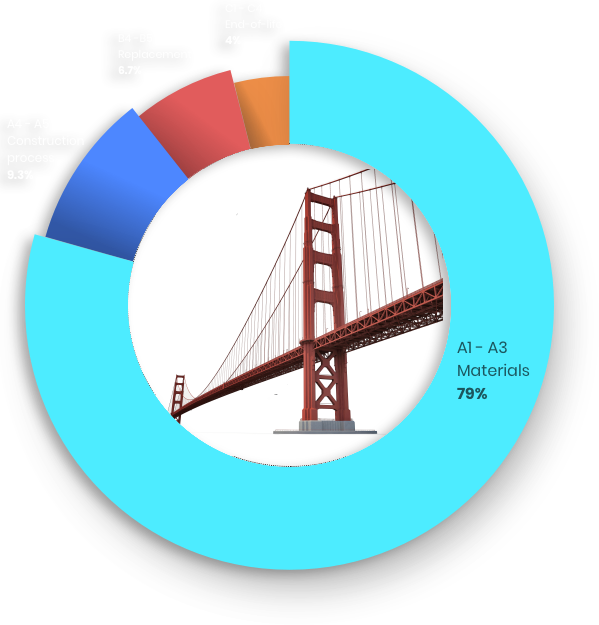Regulations
Stress-free EU Taxonomy alignment
Automated reporting software tailored to the buildings and construction sector.
EU taxonomy solutions for construction
What is the EU Taxonomy?
The EU Sustainable Finance Taxonomy aims to make it easier to identify green investments by building a common framework of sustainable economic activities.
It has six environmental objectives, of which two are currently applicable, climate change mitigation and climate change adaptation. The other objectives (water and marine resources, transition to a circular economy, pollution prevention and control, and biodiversity and ecosystems) will be applicable from January 2023.
How does the Taxonomy work?
All economic activity is defined as either eligible or ineligible for Taxonomy alignment.
To be considered Taxonomy aligned, eligible activities must demonstrate that they:
- Make a substantial contribution to at least one environmental objective.
- Do no significant harm to any other environmental objective.
- Comply with minimum social safeguards and technical screening criteria.
Who needs to comply?
The Taxonomy is mandatory for:
-
Financial market participants, such as investors based or listed in the EU/EEA.
- Large, listed companies. But likely to become mandatory for all large companies based or listed in the EU/EEA, under the EU’s proposed Corporate Sustainability Directive.
Most firms in the construction sector will need to comply to some degree, whether disclosing their own activities or on behalf of owner or investor clients.
Whatever your reporting requirements, we have a tool to help you comply
Taxonomy-compliant tools for construction projects, products and portfolios
New building design & construction
Infrastructure & civil engineering
Products and manufacturing



Easily calculate and report Global Warming Potential
- Perform Level(s) compliant GWP assessments and EN 15978 compliant LCA.
- Report carbon emissions, find hotspots and optimise your projects.
- Import pre-defined building models quickly from Carbon Designer 3D to save time.
Secure investments with Taxonomy compliant reporting
- Perform EN 17472-compliant LCAs.
- Measure embodied carbon impact with supplier-specific data.
- Calculate percentage of Construction & Demolition Waste reused or recycled.
- GHG accounting for scopes 1-3 in line with EU requirements.
Easily calculate and report Global Warming Potential
- Perform Level(s) compliant GWP assessments and EN 15978 compliant LCA.
- Report carbon emissions, find hotspots and optimise your projects.
- Import pre-defined building models quickly from Carbon Designer 3D to save time.
One Click LCA tools
One Click LCA tools
One Click LCA tools
Who can use One Click LCA for Taxonomy reporting?
From real estate investors to architects, engineers, contractors and manufacturers, One Click LCA offers a range of tools for Taxonomy-compliant reporting.



Investors, developers and asset owners
Consultants, architects, engineers and contractors
Manufacturers
Frequently asked questions
Which types of organizations or companies are affected by the EU Taxonomy?
Under its current scope, the Taxonomy requires reporting from three groups:The EU and its Member States.Financial organisations (whether banks, pension companies, or investment and insurance firms).Non-financial companies that are currently covered by the Non-Financial Reporting Directive (NFRD), i.e. large, listed public-interest companies with over 500 employees. and a net turnover of more than 40 million euros.However, the scope for which non-financial companies are required to report is set to change as the European Commission is set to replace the NFRD with a proposed Corporate Sustainability Reporting Directive (CSRD).Under the CSRD, reporting will be required by all large companies, whether listed or not. CSRD defines a large company as one where two of the following three conditions apply: an average number of 250 employees, a balance sheet total of €20m; net turnover of €40m. Effectively, this will expand the number of companies that must adhere to the Taxonomy from around 11,000 to around 50,000.Almost all business activities that contribute to the environment are affected to some degree by the Taxonomy. Financial service companies, including pension providers, large companies, listed companies and other public-interest entities, the EU and its Member States.
Which activities or projects within the built environment sector are affected by the EU Taxonomy?
The main activities and types of projects within the built environment sector covered by the Taxonomy are as follows: Acquisition and ownership of buildingsConstruction of new buildingsRenovation of existing buildingsIndividual measures, Installation, maintenance and repair of:energy efficiency equipment; charging stations for electric vehicles in buildings; instruments and devices for measuring, regulation and controlling energy performance of buildings; renewable energy technologies.
How do I comply with the EU Taxonomy?
There are three core steps to complying with the Taxonomy:Determine which of your business activities are eligible.Assess activities against technical screening criteria.Calculate your alignment with the EU Taxonomy.
My country has local LCA regulations, are they compliant with the EU Taxonomy?
The EU Taxonomy allows for local regulations to be used for Taxonomy reporting. One Click LCA’s local compliance tools in the Netherlands, Sweden and France can be used for Taxonomy-compliant reporting.
How does GHG reporting differ from life-cycle assessment?
The GHG Protocol groups emissions into different scopes according to who directly controls the emissions-releasing activity – the reporting company or another organisation. By contrast, an LCA is not concerned with who controls an activity, just that it happens.The standard emission factors basis is different: The GHG Protocol scopes 1 and 2 only take into account direct (combustion) emissions, whereas LCAs always use life-cycle based emission factors and consider all GHG gases.The GHG Protocol reports emissions based on the period in which they arose, often a calendar year or a quarter. Where future emissions are locked-in by sold products, they are accounted for in Scope 3 emissions in specific categories. An LCA looks at the entire life-cycle of a product or service: from first manufacture to end-of-life, as well as impacts beyond the system boundary. LCA results are grouped into life-cycle modules A to D.
As an investor can I use the tool?
Yes, you can use One Click LCA yourself or opt for an owner licence which allows your construction project teams and consultants to use our Taxonomy-compliant tools to perform the carbon reporting on your company account.
